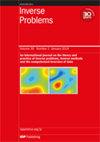Solving Bayesian inverse problems with expensive likelihoods using constrained Gaussian processes and active learning
IF 2
2区 数学
Q1 MATHEMATICS, APPLIED
引用次数: 0
Abstract
Solving inverse problems using Bayesian methods can become prohibitively expensive when likelihood evaluations involve complex and large scale numerical models. A common approach to circumvent this issue is to approximate the forward model or the likelihood function with a surrogate model. But also there, due to limited computational resources, only a few training points are available in many practically relevant cases. Thus, it can be advantageous to model the additional uncertainties of the surrogate in order to incorporate the epistemic uncertainty due to limited data. In this paper, we develop a novel approach to approximate the log likelihood by a constrained Gaussian process based on prior knowledge about its boundedness. This improves the accuracy of the surrogate approximation without increasing the number of training samples. Additionally, we introduce a formulation to integrate the epistemic uncertainty due to limited training points into the posterior density approximation. This is combined with a state of the art active learning strategy for selecting training points, which allows to approximate posterior densities in higher dimensions very efficiently. We demonstrate the fast convergence of our approach for a benchmark problem and infer a random field that is discretized by 30 parameters using only about 1000 model evaluations. In a practically relevant example, the parameters of a reduced lung model are calibrated based on flow observations over time and voltage measurements from a coupled electrical impedance tomography simulation.利用受限高斯过程和主动学习解决具有昂贵似然的贝叶斯逆问题
使用贝叶斯方法解决逆问题时,如果似然值评估涉及复杂的大规模数值模型,则成本会高得令人望而却步。规避这一问题的常用方法是用替代模型近似前向模型或似然函数。但同样,由于计算资源有限,在许多实际相关案例中,只有少数几个训练点可用。因此,对代理模型的额外不确定性进行建模,以纳入因数据有限而产生的认识不确定性,可能会很有优势。在本文中,我们开发了一种新方法,根据关于对数似然有界性的先验知识,用受约束高斯过程来近似对数似然。这在不增加训练样本数量的情况下提高了代理近似的准确性。此外,我们还引入了一种方法,将有限训练点导致的认识不确定性整合到后验密度近似中。这种方法结合了最先进的主动学习策略来选择训练点,从而可以非常高效地逼近更高维的后验密度。我们在一个基准问题上演示了我们的方法的快速收敛性,只用了大约 1000 次模型评估就推断出了一个由 30 个参数离散的随机场。在一个具有实际意义的例子中,我们根据随时间变化的流量观测结果和耦合电阻抗断层扫描模拟的电压测量结果,校准了还原肺模型的参数。
本文章由计算机程序翻译,如有差异,请以英文原文为准。
求助全文
约1分钟内获得全文
求助全文
来源期刊

Inverse Problems
数学-物理:数学物理
CiteScore
4.40
自引率
14.30%
发文量
115
审稿时长
2.3 months
期刊介绍:
An interdisciplinary journal combining mathematical and experimental papers on inverse problems with theoretical, numerical and practical approaches to their solution.
As well as applied mathematicians, physical scientists and engineers, the readership includes those working in geophysics, radar, optics, biology, acoustics, communication theory, signal processing and imaging, among others.
The emphasis is on publishing original contributions to methods of solving mathematical, physical and applied problems. To be publishable in this journal, papers must meet the highest standards of scientific quality, contain significant and original new science and should present substantial advancement in the field. Due to the broad scope of the journal, we require that authors provide sufficient introductory material to appeal to the wide readership and that articles which are not explicitly applied include a discussion of possible applications.
 求助内容:
求助内容: 应助结果提醒方式:
应助结果提醒方式:


